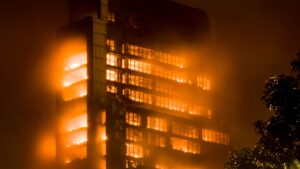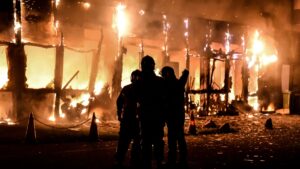In the face of a fire outbreak, the world can turn upside down in an instant. The destructive force of flames can leave behind a trail of devastation, both physically and emotionally. But amidst the ashes, there is an undeniable strength that emerges—a resilience that fuels the journey towards recovery.

In this post, we will embark on a powerful exploration of the aftermath of a fire, delving into the steps you need to take to address the aftermath while ensuring that safety measures are followed. It is through knowledge, preparation, and a steadfast commitment to rebuilding that we can rise from the ashes stronger than before.
Ensuring Safety First: Assessing the Damage and Securing the Area
After a fire, the first priority is to ensure the safety of yourself and others. As tempting as it may be to rush into the space to assess the damage, it is crucial to wait until the fire department or relevant authorities deem it safe to enter. The structural integrity of the building may have been compromised, and there may be lingering hazards such as weakened floors, falling debris, or hidden electrical dangers.
Once given the green light to enter, conduct a thorough assessment of the damage. Take photographs or videos to document the extent of the destruction. This documentation will be crucial for insurance claims and as evidence for any legal or investigative purposes. Make note of any valuable or sentimental items that have been lost or damaged. Further, install temporary fencing around the affected space to keep out curious onlookers and potential trespassers. If necessary, consider hiring a professional security service to monitor the site and ensure the safety of the property.
Contacting Your Insurance Provider and Assisting Investigations
One of the first calls you should make is to your insurance provider. Inform them about the fire incident and start the claims process. Be prepared to provide detailed information, such as the date and time of the fire, a description of the events leading up to the fire outbreak, and the extent of the damage. Your insurance agent will guide you through the necessary steps and documentation required to process your claim.
In addition to contacting your insurance provider, it is important to assist with any investigations into the cause of the fire. If the fire was severe or of suspicious origin, local authorities or fire department investigators may need to conduct an investigation. Cooperate fully with their inquiries, providing any relevant information or evidence you have. Understanding the cause of the fire is not only crucial for insurance purposes but also for future prevention and safety measures.

Mitigating Further Damage: Cleaning and Salvaging Possessions
Once the safety measures have been established and the initial assessment has been conducted, it’s time to address the task of cleaning and salvaging your possessions. This process can be emotionally challenging, as you may come across cherished items that have been damaged or destroyed by the fire. However, with a systematic approach and professional assistance, you can salvage what is salvageable and begin the process of rebuilding your belongings.
Start by sorting through your possessions and categorizing them into salvageable and unsalvageable items. Salvageable items may include those that have only suffered minor smoke or water damage. It is essential to act quickly to prevent further damage caused by residual smoke or water. Consult with professional restoration services specializing in fire damage to assist you with the cleaning and restoration process.
Evaluating and Restoring the Property
With the immediate concerns of safety, assessment, and cleaning addressed, it’s time to evaluate the extent of the damage to the property and begin the restoration process. This step is crucial in determining the scope of work required and coordinating the necessary repairs and renovations. Engage the services of professional contractors or restoration specialists who have experience in fire-damaged properties.
During the restoration process, it is important to communicate openly and regularly with the professionals working on your property. Maintain a clear line of communication, express any concerns or preferences, and ask for regular progress updates. This ensures that the restoration aligns with your expectations and allows for adjustments to be made if necessary. Keep in mind that the restoration process may take time, depending on the extent of the damage and the availability of materials and labor.
Embracing a Fresh Start: Rebuilding and Moving Forward
As the restoration process nears completion, it’s time to shift your focus toward rebuilding and moving forward. Embrace this opportunity for a fresh start and consider it as a chance to make improvements and enhancements to your property. Whether it’s upgrading the fire safety systems, implementing more efficient energy solutions, or redesigning the layout for improved flow, this is the perfect time to incorporate innovative ideas and modern advancements into your rebuilt space.
Alongside the physical restoration, prioritize the emotional healing process as well. A fire can be a traumatic event, and it’s important to take the necessary steps to support your well-being and that of your loved ones. Seek emotional support through counseling or support groups if needed and surround yourself with a strong support system to help you navigate through the emotional challenges of rebuilding. Remember that the process of rebuilding and moving forward is not a linear one.
Conclusion
The aftermath of a fire is a challenging and transformative experience that tests your strength and resilience. It is during these moments that you have the opportunity to rise above adversity and rebuild your life with determination and purpose. By following the steps outlined in this blog post, you can navigate the complexities of addressing the aftermath of a fire while ensuring the safety of yourself and others.
Remember, the recovery process takes time and patience, and it is important to seek support from professionals, friends, and family along the way. From securing the area and salvaging possessions to evaluating the property and rebuilding, your journey towards recovery is a testament to your unwavering spirit. Embrace the challenges, embrace the opportunity to rebuild, and let the fire within you illuminate the path to a brighter and more resilient future.
